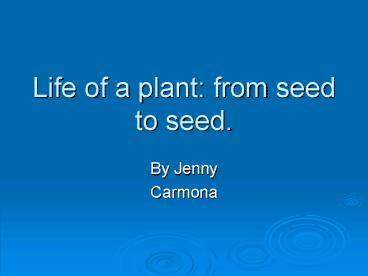Life of a plant: from seed to seed' PowerPoint PPT Presentation
1 / 15
Title: Life of a plant: from seed to seed'
1
Life of a plant from seed to seed.
- By Jenny
- Carmona
2
Germination
- Definition the first stage or the beginning
growth of a seed to plant - Water enters the seed through the little hole at
the side called the - Micropyle - The water activates gibberellin - A hormone
needed to break the dormancy of the seed. - The seed then shoots off roots and the seed then
absorbs water and nutrients from the soil.
3
Leaves
- Cotyledon - are the first leaves after the
germination stage. - Monocotydon only having one cotyledon.
- Dicotyledons (Dicot) - is the name for the group
of plants having two cotyledons.
- After that stage there comes the first true
leaves.
4
Photosynthesis
- Photosynthesis is the process of the plant
absorbing sunlight and converting it to nutrients
and sugar. - To begin the plant only needs light, CO2 and H2O
to make sugar. - Photosynthesis releases water, oxygen, and
glucose.
- The leaves basically produce photosynthesis. This
is because of the vascular bundles ( the vain
looking things)
5
Nutrients
- The plants need 12 kinds of nutrients from the
soil. - Nitrogen, phosphorus, potassium, calcium,
magneslum, sulphur, iron, manganese, zinc, boron,
copper, and molybdenum. - Just like we need nutrients a plant also needs to
have the right amount of nutrients to produce
good crop growth. - If the plant does not have the necessary
nutrients it will result in poor crop growth.
6
Sunlight and water
- Most plants need about 4 to 6 hours of sunlight a
day - But some need less or more sunlight then other
plants do. - Direct and indirect sunlight affect the growth
of a plant - Having more sunlight can speed up the process of
growth.
- Its very important to keep the soil consistenly
moist - If you dont, the chance your plant will die will
increase. - Plants, especially when there young, are very
delicate.
7
Pollination
- Pollen are yellow tiny egg-shaped male cells of
flowering plants. - The transfer of pollen from the stamen (male part
of the plant) to the stigma (female part of the
plant). - Pollination can happen by the wind, and insects
or water. - The percentage of pollination transfer is, 2 by
water and 98 by the wind.
8
Stress
- If the plant isn't getting enough or is receiving
too much sunlight and/or water the plant will
mature faster. - Because its trying to get nutrients from the
soil. - If the plant doesnt have the nutrients it needs
that causes if to be under stress. - Pest/insets eating the plant causes it to stress
out as well.
- Another thing is when the plant is under stress
it will seed for the next generation. - In addition weed competition is another factor to
cause stress. - When the plant holds to much stress it will
result in growth stunted growth. - On the farm we cleared out the blackberries so
the evergreen trees is grow larger.
9
Under what condition will it seed
- Temperature - A seed will germinate quickly and
vigorously with the right temperature. This is an
important point to consider. Sometimes you can
see the temperature the seeds need to germinate
on the back of the packet or you look it up in a
book. - Moisture - seeds need to be moist in order to
grow. If you give it too much water you will cool
it down.
- Light the amount of light varies from seed to
seed. Some seeds germinate in the light while
some germinate at night. Check on the packet you
bought the seed or look it up in a book - Once your seed germinates, it is now a seedling.
Seedlings dont need high temperature but they
need warmth. - Seedlings need protection form draughts and pest
and diseases.
10
Saving And Protecting
- Saving
- If you have bad insects try to get beneficial
insect to eat them. - If you have too many plants growing in one area,
take some out, that will make the plant grow
faster and healthier. - Sometimes plants just need water and sunlight
- Protecting
- Seedlings needs protection form draughts, pest
and diseases. - Weather changes. (snow, heat waves, floods, ect)
- Animals can be a big problem too. (deer, gofers,
and other animals that live underground.)
11
Saving/Storing Seeds
- When you harvest them too soon, your seeds will
produce thin and unsubstantial food. - But if you wait too long to collect your seeds,
you are in danger of losing them to wind or
animals. - The majority of seeds like to be stored in cool,
dark and dry circumstances. (Note that some
seeds vary) - If you store them correctly they could last for
40 years!
12
Life cycle
13
Beginning life
14
Mid life
15
End life

